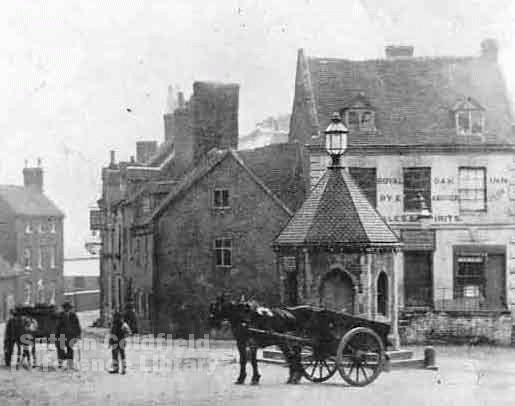Richard Holbeche was born in 1850 in a large house, no.1 Coleshill Street. Over forty years later, on his return from abroad, he found Sutton Coldfield much changed. It was no longer the quiet market town of his youth, so he wrote a memoir of his childhood years, recalling the folk of “Old Sutton, before the railway came” while it was fresh in his memory. In those days there were buildings on the opposite side of Coleshill Street from the Holbeche house, where Vesey Gardens is now, and he wrote about the people who used to live there.
The house next to the churchyard was where “Commander the policeman (mark! the one and only policeman for Sutton) lived in the white house”. The 1861 census shows that 31-year old George Commander from Leamington Spa, his wife Sarah and two infant children were living there; it was a good-sized house, the previous occupant being widow Sandon who had a live-in servant; her architect grandson also lived there with his sister. The next house was smaller, a shop with a board over the door reading “Jane Botteril, licensed to sell tea, coffee, pepper, vinegar, tobacco and snuff”. Richard Holbeche remembered buying sticky sweets there as well as bran for his rabbits, and firing a pea-shooter from a window opposite which broke Mrs. Botteril’s window.
The 1851 and 1861 censuses show that the next house, also quite small, was tenanted by Thomas Tailor the carpenter and his family, but Holbeche remembered it as the home of the Neales, who moved in after 1861. He was great friends with the Neale boys, whose father was “a boot-maker, bent and bandy-legged, who attended…to the Weighbridge (called by the irreverent The Pepper Pot)”.
Next was the Old Sun public house, an old building first recorded in 1646 as a farmhouse; the adjacent cottages were converted from farm outbuildings in the 1750s. In the 1850s it used to be, according to Holbeche, “a great meeting place for Birmingham tradesmen, who on Sundays drove their wives, in gay bonnets, to take the Sutton air. They came in smart dog-carts drawn by fast trotting ponies.” Next door lived John Short, an agricultural labourer born in nearby Middleton parish - in 1851 his children Sarah and Thomas were aged 12 and 8, but they had left home by 1860, and Holbeche remembered Mr. and Mrs. Short as “a worthy couple who had a relation named Moses Dyke.” This Moses is shown as a “Nurse child” aged 2 in 1851, and as a lodger aged 12 in 1861.
Mrs Allen had the next house, and Mrs. Perkins the last house, on the corner of Mill Street, as remembered in the memoir, “They both sold cheap sweet stuffs much affected by my brother Will and myself…if their wares such as brandy-snap were kept in a trouser pocket the flavour was superior, also with treacle-stick which was invariably wrapped in leaves of the Bible.” Their husbands, Joseph Perkins and Isaac Allen, were both labourers.
Richard Holbeche’s fond memories of these people who lived on the other side of the road from his grand house were coloured by his idea of the old country-town Sutton, where no doubt these ordinary folk looked up to their gentry neighbours.
